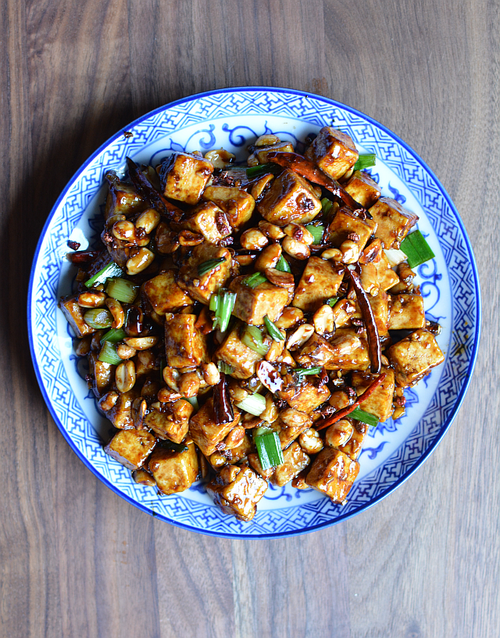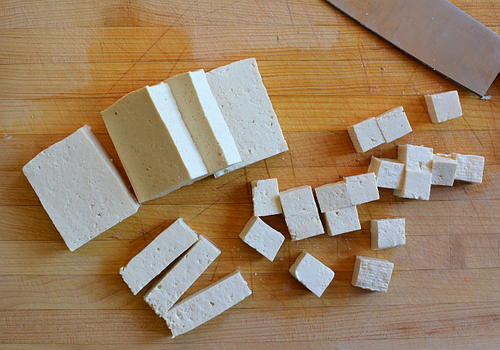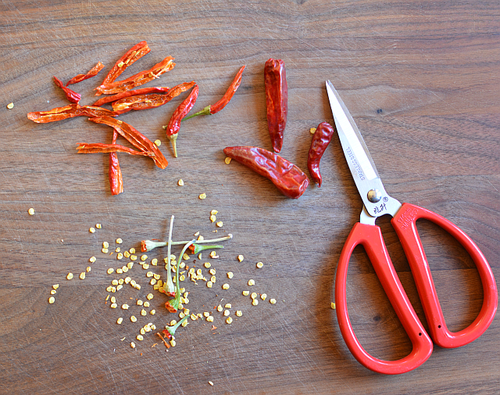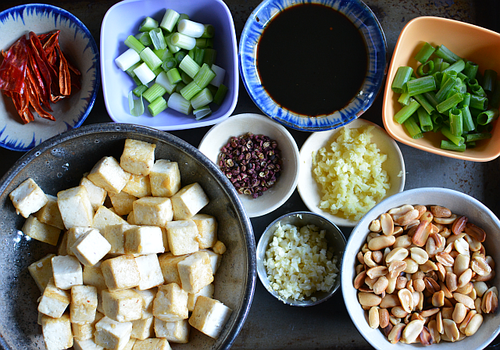
I cannot remember when I last ordered kung pao anything at a restaurant. I gave up on it because the restaurant-style sauce was either super sweet or indistinct and there were often few peanuts. Peanuts are cheap and I’ve not known why some restaurants skimp or skip it.
I love the peanuts in kung pao because they offer texture and richness. The ideal kung pao sauce is hearty, spicy, tangy. A well-made kung pao stir-fry is serious tasting food – with blistered dried chiles and numbing Sichuan peppercorns. What I’ve described is the kung pao stir-fry that I make at home. It’s not rocket science and I typically use chicken.
While I was in Vietnam, Rory decided to eat less animal protein, shunning his weekly steak for lentils, tofu, or tempeh. I came home and he confessed that he’d been making dal, searing tofu, and tempeh with recipes of mine. We didn’t eat much meat before and now we’re eating a little less.
With the cool fall temperatures, I thought of tackling kung pao tofu. It’s warming vegetarian food. The foundation is a favorite recipe that I wrote for an iPhone app of mine called the Asian Market Shopper. A reader emailed about setting up an Asian pantry and I directed her to the app as a handy means to navigate an Asian market. The AMS is a mobile Asian ingredient glossary, with entries for 100 pantry ingredients, brand recommendations, as well as an audio pronunciation guide. There are recipes in the app too, including my favorite kung pao chicken recipe. Writing to her about the app triggered my thinking about that kung pao recipe.
So I turned the app’s kung pao chicken recipe into a kung pao tofu dish. It was splendid but required a little manipulation of the tofu.
What’s key is using extra-firm tofu (here's video tip on tofu textures) and searing to give it personality. Most kung pao tofu leave the tofu naked and boring. I wanted my tofu to stand up to the bold kung pao flavors – lots of garlic, ginger, chiles, peppercorn, vinegar and soy sauce. The dish needed to wow with flavors and textures that popped.


A coating of cornstarch lent body to the tofu, absorbed moisture, and helped the tofu slightly brown quickly. During stir-frying, I splashed in some seasonings to layer on flavors.
Another thing I do for kung pao, whether there is meat or tofu involved, is to fry the peanuts. Even though they are already roasted, they express themselves better by being refreshed.
When we ate the kung pao tofu, Rory remarked, “You totally don’t miss the meat and it’s got a lot of heat.” I think it’s a keeper.
RECIPE
Kung Pao Tofu
Gong Bao Dou Fu
Serves: 2 as main dish, 4 as part of a multidish meal
Ingredients
- 12 ounces (360 g) extra-firm tofu
- ½ teaspoon salt
- 2 teaspoons cornstarch
- 3 to 4 tablespoon canola oil, divided
- ½ to ⅔ cup roasted, unsalted peanuts
Seasoning sauce 1
- 2 teaspoons regular soy sauce
- 1 teaspoon Shaoxing rice wine or dry sherry
Seasoning sauce 2
- ¾ teaspoon cornstarch
- 1 teaspoon regular soy sauce
- 1 tablespoon sugar
- 1 teaspoon dark soy sauce, or ¾ teaspoon regular soy sauce and ¼ teaspoon molasses
- 1 tablespoon Chinkiang vinegar, or 1 ½ teaspoons balsamic and 1 ½ teaspoons cider vinegar
- 1 teaspoon toasted sesame oil
- 6 to 10 dried red chiles, stemmed, halved lengthwise with scissors, seeds discarded
- ¾ teaspoon Sichuan peppercorns
- 1 tablespoon minced garlic
- 1 tablespoon minced fresh ginger
- White part of 4 large green onions, cut to match size of peanuts
- Green part of 1 large green onion, cut to match size of peanuts
Instructions
- Cut the tofu into thumb nail-size cubes. Let drain on paper towel for 10 minutes. Pat away excess moisture then season with the salt. Lightly coat in the cornstarch and set aside.
- Heat 1 to 2 tablespoons of oil in a large wok or skillet over medium-high or high heat. Add the tofu (work in batches, if needed), then cook for about 2 minutes, tossing and stirring to lightly sear the tofu. Transfer to bowl and set aside.
- Reheat the wok or skillet over medium-high heat until bead of water evaporates in 2 to 3 seconds. Add 2 tablespoons of oil and the peanuts, stirring constantly for 1 to 2 minutes, until fragrant; take care not to burn them. Use a slotted spoon to transfer peanuts to small plate, leaving excess oil behind.
- Stir together the ingredients for each of the seasoning sauces, keeping them separate. Set near the stove with the remaining ingredients from dried red chiles down to the green onion.
- Reheat the wok or skillet over high heat. Add the hiles and Sichuan peppercorns. Stir briskly for 20 seconds, until aromatic and crisp. Add the tofu, give things a stir, then splash in seasoning sauce 1. Let the tofu absorb the seasonings, then add the garlic, ginger and white scallion parts. Stir-fry for 1 minute more to cook through and become aromatic.
- Give seasoning sauce 2 one last stir, then add to wok. When sauce is thick and coats things, about 30 seconds, return the peanuts and add cut green scallion parts. Stir, transfer to a plate, and serve.
More spicy vegetarian recipes to warm you up:
Interested in taking cooking classes with me? I just opened registration for 2016 classes. Join me or help spread the word. Thanks!


















Emi Nguyen says
Hi Andrea,
This dish came out very good except the peanuts I burned. Despite of your warning, I took my eyes off from the wok (less then a minute) to read the recipe. They cooked pretty fast. I loved the texture and the taste of this tofu so much that I don't miss the chicken at all. It was a perfect dish to make on the new year's day! Thank you.
Andrea Nguyen says
The peanuts don't seem to do anything and then the wok heats up big time! No problem. There's always another batch to be made. Thanks for taking time to cook and write!